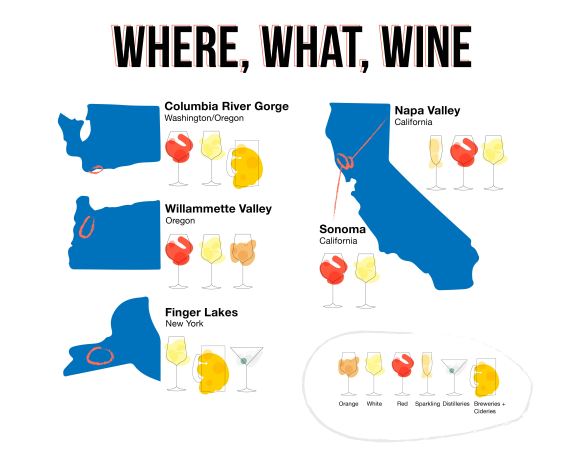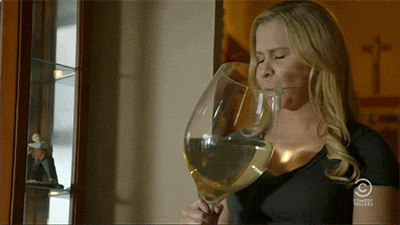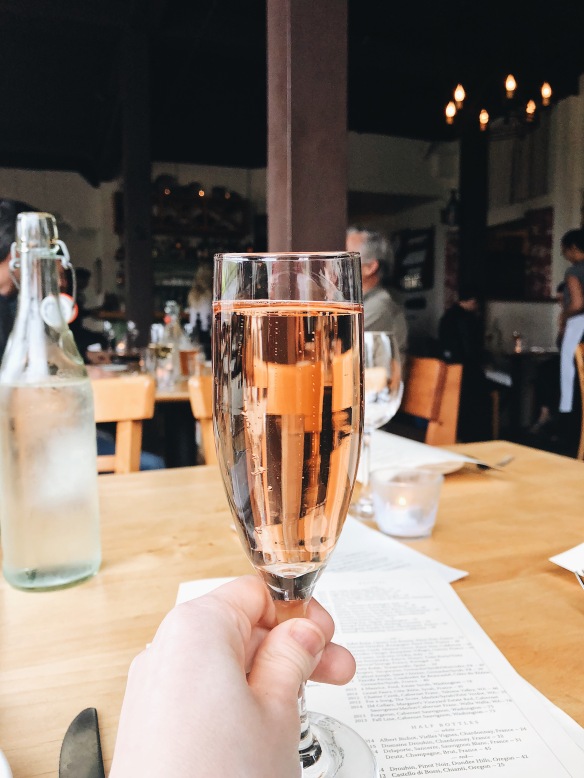With the release of the Netflix film Wine Country, it’s obvious that friend getaways spent swirling around to myriad wine tastings have made it deep into the mainstream. After all, what’s better than escaping your day-to-day to spend some deserved time tipping back glasses with your best pals?
Here’s one thing that’s better: a trip to wine country that reaps the rewards of an evening spent doing some thoughtful, proactive planning. There are a few bases to cover. Let’s start at the beginning —
So, you want to go to wine country.
If you throw a dart at a map of the US, there’s a distinct possibility that you’ll land somewhere in the vicinity of a wine producing region. From the highlands of Texas to the picturesque, sprawling vineyards throughout California, all the way to the shores of Lake Michigan — which I just learned some people refer to as “Napa of the Midwest” — there are plenty of potential wine-fueled weekends to be had.
So, where is wine country?
Let’s start with the U.S. — 
There are a *lot* of wine regions in the United States; lots of wine regions, built on lots of different geographies, experiencing lots of different climates. AKA there’s a whole lot of different wine being produced here. While there are many different wine regions, these are the ones that have kept my attention:
- California boasts over 4,000 wineries statewide. While the Napa and Sonoma Valleys are very hyped, don’t hesitate to look into other wine growing areas to quench your thirst. Hint: check out Paso Robles in the Central Valley and/or even wineries in coastal areas like Malibu (see links in the resources at the end of this article for more hints).
- Washington State has a total of 14 different American Viticulatural Areas (AVAs) — which can also be read as: Wow there’s so much wine!—and a reputation for producing some high quality juice. Of all the wine regions I’ve visited in Washington so far, the Columbia River Gorge is my favorite.
- Oregon gives us the Willamette Valley. Fun fact, it’s located along the same latitude as France’s famed Burgundy region. What’s another thing both regions have in common? Very tasty Pinot Noir. Here you’ll find a plethora of producers doing both conventional and unconventional wines. (Oh! And several Willamette producers pour in Portland..which is why some people call it Pourtland…or not).
- Lastly, upstate New York in the Fingerlakes region. If you visit this area, you’ll find a wealth of Riesling, Gewürztraminer, Cab Franc as well as a variety of breweries, and distilleries. So many opportunities for activities!
TL;DR — There are basically countless wine regions in the U.S.—do a Google! One may be closer than you think.
Outside of the US —
Obviously there are a lot of wine regions in Europe, Australia, South America, and elsewhere. These are a whole different beast and require the same sort of research, and more planning. Feel free to email me if you have specific questions!
So, what are your priorities?
Before choosing precisely where to go, it might benefit you to noodle over your priorities. If you’re stuck, start with these questions—
Flavor: What kind of wines do you like to drink?
Are you a fan of Big Bold Reds or a die hard for Crisp Clean Whites? These sorts of preferences can help guide which region you choose. For example, Napa is more known for its Chardonnay, Merlot and Cabernet Sauvignon (Cab Sav if you’re fancy), while the Willamette Valley specializes in Pinot Noir and also Riesling, Chardonnay (grown in a different climate than Napa), and Gamay.
Despite what my brother has embraced as his key wine belief, wine tastes differently depending on what kind of grape it is and where it’s grown. If you’re feeling overwhelmed by the options, try asking someone who works at your local wine shop.
Distance: Do you want to stay close to home or are you into the idea of going further away? If you’re thinking of going on a more adventurous trip, how will you get there?
To summarize: research is important unless you DGAF because you just want wine. No shame in that game, either! Live your best life!

So, when are you going?
As a person who hates to be caught in a crowd (cue: my social anxiety), I tend to try and avoid peak tourist seasons when I’m traveling. With wine country, though, it has it’s pros and cons.
Cons: Peak tourist season can mean bigger crowds, higher tasting fees, and a more expensive trip in general. It can also mean that it’ll be harder for you to get a reservation at the reservation-only wineries.
Pros: On the other hand, peak tourist season goes hand-in-hand with Harvest season, which can come with excellent benefits (such as discounts or limited releases of specific bottles).

So, where are you staying?
I’m not saying that your decisions about where to stay will make or break your trip, but it can definitely influence what you’re able to drink—I mean accomplish.
One of the first questions I ask myself when planning a wine trip is: will I stay in-town or outside of town? For the more spread out wine regions, such as the Willamette Valley, finding a home base in the right area can make a difference in which wineries you’re able to visit. In general, choosing something more central might offer the most flexibility, but opting for a small, quaint cottage in the thick of the vineyards ain’t bad either.
AirBNB vs Hotel vs etc
While hotels may come with benefits—like a wine shuttle—AirBnB’s guarantee privacy, and the perfect, positive-vibes-only spot to drink all those bottles you bought to waive your tasting fees.
When trying to decide between the two options, here are a few things worth considering:
- Do you want access to a kitchen? Personally, I love a family meal on a wine trip.
- What kind of relaxation are you looking for? Different amenities are available in different places. And by amenities I mean hot tubs.
- Comfort. Maybe you prefer the security of a hotel, or the feeling of arriving back to “your” house after a long day of sipping the grape. Factors of comfort are different for everyone, and comfort is key.
- Convenience — location, location, location. Pick what makes most sense for your adventure. Look at it on Google Maps before you book…trust me.
So, how are you getting around?
Wine trips mean that you’ll spend a lot of time getting from one winery to another. Would you and/or your group rather drive yourself, or hire someone else to drive you?
Driving yourself
Driving yourself means that someone in your group is committing to being the designated driver, for one day or for the whole trip. If one or more people can commit to abbreviating their drinking throughout the wine tasting time then I say: go for it. If not—nah! Why? Because driving under the influence is dangerous! Do not make me say it again!
Oh, you all wanted to enthusiastically take part in your debauchery? Don’t worry. There are other options that allow everyone to maximize their tastings, and minimize their obligatory wine dumping.

Hiring someone else to drive you
From my perspective, there are two clear options here: bus/shuttle services or hiring a private driver.
By signing up for a bus service you know that transporation is covered and its origin is probably a centralized pick-up/drop off spot (extra points if it’s close to where you’re staying). There are a variety of bus services (private and public), and some of then run all day as a hop-on, hop-off service. If you’re a fan of convenient and lower effort options then this is your huckleberry.
The cons of a bus service are price variability and limited options. Oftentimes the route of the bus is already charted so you’ll have less flexibility when it comes to choosing wineries to visit. This isn’t ideal if you’re opinionated about where you want to taste. (Me. I’m talking about me.)

The second answer to this is to hire a private driver. Because you’ll have hired the driver for the day (or for the weekend if you really want to ball out) you’re giving yourself the opportunity to participate in a fully customizable experience. If your driver has been at it for awhile, they likely have relationships with wineries that aren’t open to busses or most groups. Another plus, the driver will probably remain at a location until you’re ready to pile in and head to the next stop. Oh, and pick-up and drop-off will likely be at your doorstep. Yes please.
I don’t have to tell you that this is definitely a more expensive option. However, you get what you pay for. What I’ll tell you instead is that I hired a private driver in Alsace and I have NEVER looked back.
So, which wineries will you visit?
Finally, the most fun part (for me): choosing which wineries to visit. This part could become intimidating, but it’s nothing an afternoon of research can’t sort out. Here’s where I like to start:
Types of wine offered (variety)
Depending on the region, I love to make sure I plan in a way that allows me to taste a variety of wines. This way the tastings don’t get monotonous, and I may even get to try something new.
Reputation
While a winery may be a cult favorite or a Name Brand, this doesn’t mean that the wines you taste will be mind blowing. Do your research, read reviews, and remember that hype doesn’t always = quality.
NOTE: ~Sometimes~ the more interesting, memorable wines will be found at the smaller producers.
Great sources for wine research are: instagram, reaching out to wine writers or distributors in your city, or asking your wine-loving friends (even that person you haven’t talked to on Facebook in 10 years).
Reservations
Some wineries require reservations for tastings, especially if you are visiting with a group. It’s important to clarify this beforehand so you don’t end up with an empty glass (full of disappointment).
Tasting fees
Tasting fees vary by region and winery. More popular areas are likely to have higher tasting costs, and likely this extends to more popular wineries as well. Before visiting a winery, see if there’s an event calendar on their website. This way you can determine if there’s an event while you’re there that offers a more enhanced experience, or one that results in lower fees.
So, here are some FINAL hot tips to consider:
-
- Don’t overbook yourself. Be realistic with what you can achieve, and give yourself time and space to relax. You never know when you might rather sit in a circle of Adirondack chairs and split a bottle with your buds rather than finishing the day with a final tasting.
- Don’t get wasted. I mean, you can if you want, but speaking as the person who just saw a man um…lose his wine into a small bag on a wine bus, I’d recommend not. Wait until you’re done for the day to invert your bottles. (Also drink water so you are not horribly hungover for the next day!)
- Do remember that even after all of this planning it’s also ok to be spontaneous. As with any other kind of traveling, you never know what helpful tidbit of information you’ll learn from your hotel concierge, your driver, or the vivacious individual you spoke to while in line for the bathroom between swigs of last year’s very different expressions of pinots.
Wine country is all about choosing your own adventure. Maybe you’re a planner, and maybe you’re not. If you want to make the most of your visit, spend an evening figuring out the details. Investing time in planning now means more time for stress-free wine drinking later.
And if you don’t want to plan the trip yourself, Gastrono.me is always happy to help.
Clink!

—








